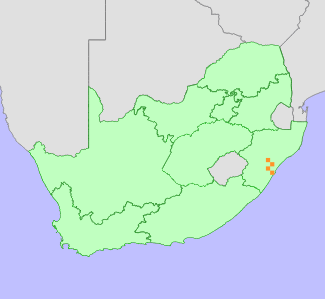|
Scientific Name | Hesperantha gracilis Baker |
Higher Classification | Monocotyledons |
Family | IRIDACEAE |
National Status |
Status and Criteria | Vulnerable D2 |
Assessment Date | 2021/05/31 |
Assessor(s) | D. Raimondo, L. von Staden & T. Patel |
Justification | This range-restricted habitat specialist (extent of occurrence 717 km²) is known from four locations and it is potentially threatened by habitat degradation due to agricultural and urban expansion and alien plant invasion. It is therefore listed as Vulnerable under criteria D. |
Distribution |
Endemism | South African endemic |
Provincial distribution | KwaZulu-Natal |
Range | this species is endemic to South Africa, and is found on the hills between Durban and Pietermaritzburg in KwaZulu-Natal. |
Habitat and Ecology |
Major system | Terrestrial |
Major habitats | Northern Coastal Forest, Scarp Forest |
Description | It occurs in scarp forest, hanging from moss cushions or patches of humus on dripping wet sandstone cliffs that are mostly inaccessible. |
Threats |
| This species occurs within a rapidly expanding urban area. Although development is unlikely to directly impact this species' cliff face habitat, fragmentation and degradation of natural ecosystems, as well as changes in water drainage and runoff due to surrounding development is inevitable. Most remaining fragments of natural vegetation in the area are also densely invaded by alien invasive plants, which could potentially outcompete native species such as this one. |
Population |
This is a localized habitat specialist, known from only four locations. It has a stable population trend.
|
Population trend | Stable |
Assessment History |
Taxon assessed |
Status and Criteria |
Citation/Red List version | | Hesperantha gracilis Baker | VU D2 | Raimondo et al. (2009) | | Hesperantha gracilis Baker | VU | Scott-Shaw (1999) | | Hesperantha gracilis Baker | Vulnerable | Hilton-Taylor (1996) | |
Bibliography |
Goldblatt, P. and Manning, J.C. 2020. Iridaceae of southern Africa. Strelitzia 42. South African National Biodiversity Institute, Pretoria.
Hilliard, O.M. and Burtt, B.L. 1986. Hesperantha (Iridaceae) in Natal and nearby. Notes from the Royal Botanic Garden Edinburgh 43(3):407-438.
Hilton-Taylor, C. 1996. Red data list of southern African plants. Strelitzia 4. South African National Botanical Institute, Pretoria.
Raimondo, D., von Staden, L., Foden, W., Victor, J.E., Helme, N.A., Turner, R.C., Kamundi, D.A. and Manyama, P.A. 2009. Red List of South African Plants. Strelitzia 25. South African National Biodiversity Institute, Pretoria.
Scott-Shaw, C.R. 1999. Rare and threatened plants of KwaZulu-Natal and neighbouring regions. KwaZulu-Natal Nature Conservation Service, Pietermaritzburg.
|
Citation |
| Raimondo, D., von Staden, L. & Patel, T. 2021. Hesperantha gracilis Baker. National Assessment: Red List of South African Plants version 2024.1. Accessed on 2025/10/26 |
 Comment on this assessment
Comment on this assessment


